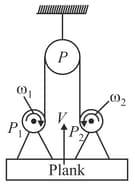Wave Motion
Wave Motion: Overview
This topic covers concepts, such as Equation of Velocity in Terms of Time, Equation of Velocity in Terms of Displacement, Laplace Correction of Newton's Relation & Pressure and Speed of Sound Wave etc.
Important Questions on Wave Motion
Figure shows the graph of velocity versus displacement of particle executing simple harmonic motion. The frequency of oscillation of the particle will be

Two pulses A and B have instantaneous velocities as shown by arrows. In which direction do these pulses travel in time?

The velocity of a particle, executing S.H.M, is at its mean position.
A sound wave of frequency is passing through air. An molecule (mass ) is set in oscillation with an amplitude of speed at the centre of its oscillation is
A string of length is clamped between two points and speed of transverse wave in it is . Now the tension is increased to four times just by making the string more tight. Neglect variation in length while increasing the tension. The new speed of transverse wave is
The displacement of two particles executing S.H.M are represented by and . The phase difference between the velocities of these particles is
The equation of a travelling wave is given by , where and are in metre and is in second. The velocity of wave is
In the figure shown two motors fixed on a plank which is hanging with light string passing over fixed Pulley . If the motors starts winding the thread with angular velocity & then velocity of plank is (here are the radii of motor rotor respectively) [Given: ]

The speed of sound depends upon the _____.
The potential energy of a particle performing SHM is given by . Which one of the following options correctly represents the graph for potential energy vs. time?
Which one of the following is the correct acceleration vs. time graph for a particle performing SHM?
Which one of the following is the correct graph for acceleration vs. displacement of a particle performing SHM?
The shape of velocity vs. time graph for a particle performing SHM is
Total energy of a body in Simple harmonic motion depends on
A person has a hearing range from . The typical wavelengths of sound waves in air corresponding to these two frequencies are: (speed of sound in air is ).
A particle performs simple harmonic motion. A large number of snapshots of its position are taken at random. A histogram of these positions will
Which of these is not a characteristic of a wave?
The equation of a progressive wave is y=0.002sin2π(2t−0.01x). Its wavelength is
A particle of mass oscillates in Simple Harmonic Motion between points and , the equilibrium position being . Which of the following graphs represents the variation of its potential energy with respect to its position?
